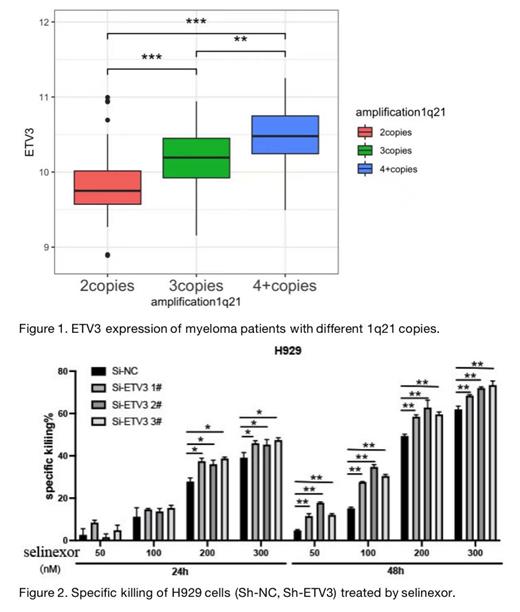Background: Gain or amplification of chromosome 1q, which characterized as a poor prognosis indicater, is one of the most frequent cytogenetic abnormalities in multiple myeloma (MM), occurring in nearly 40% of newly diagnosed patients. Though several genes, such as IL6R and CKS1B, have been reported to related to its severity, there still remains a mist for us to explore. So, we further explore the potential mechanism that may illustrate the malignant phenotype of gain or amplification of chromosome 1q in multiple myeloma, and the ETS transcription factors ETV3 may make sense.
Objective:Explore the functions ETV3 played in the malignant phenotype of gain or amplification of chromosome 1q in multiple myeloma.
Methods:Dataset GSE2658 from GEO database was used to analyze the correlation of ETV3 expression and survival of newly diagnosed multiple myeloma (NDMM). Dataset GSE4581 from GEO database was used to investigate the relationship between the number of 1q copies and expression of ETV3. Next, ETV3 expression on different myeloma cell lines was detected by RT-PCR,WB and high ETV3 expression cell lines were selected for further study. Knocking down of ETV3 on these cell lines were performed and CCK-8 was used to detected the proliferation ability. XPO-1 inhibitor selinexor was used with different concentrations (0-300nM) to treat these cells for 24h and 48h, and apoptosis was detected by flow cytometry. Further, RNAseq was performed to explore the related changed genes that might be regulated by ETV3.
Result s : Survival analysis showed MM patients with higher ETV3 expression exhibit worse prognosis according to Dataset GSE2658 (P mini=0.046). As for Dataset GSE4581, 414 patients were included, among which 186 patients carried more than 2 copies of 1q21. We found that along with the increasing of 1q21+ copies, expression of ETV3 increased (p<0.01).
The results of RT-PCR and West-blots showed that all the MM cell lines expressed different level of ETV3, among which H929 and AMO1 were extremely high. Hence, we knocked down ETV3 on these two cell lines (H929 Sh-ETV3 and AMO1 Sh-ETV3) in subsequent experiments. Results showed that after knocking down of ETV3, the proliferation rate of myeloma cells was reduced (p<0.05). Besides, myeloma cells knocked down of ETV3 were more sensitive to selinexor (p<0.01). Based on the above results, we analyzed the genes changed after knocking down of ETV3 by RNAseq, results indicated several genes such as PKN1 might play a part in this process.
Conclusion s : MM patients carrying with higher 1q21+ copies expressed higher level of ETV3 genes, which indicated a worse prognosis. Knocking down ETV3 on myeloma cells reduced their proliferation ability and enhanced their sensitivity to selinexor. PKN1 might involved in this process.
Key words: ETV3, multiple myeloma, Gain or amplification of chromosome 1q, selinexor
Disclosures
No relevant conflicts of interest to declare.


This feature is available to Subscribers Only
Sign In or Create an Account Close Modal